Business Research and Ethics Assignment: Worldview and Variables
VerifiedAdded on 2020/03/02
|5
|1277
|90
Homework Assignment
AI Summary
This assignment solution delves into the core concepts of business research, contrasting quantitative and qualitative approaches and their respective worldviews. It presents research questions suitable for both methodologies, illustrating the practical application of each. The solution then analyzes a provided research study, identifying its design, experimental groups, interventions, and control variables. It further differentiates between content and construct validity, and elucidates the roles of variables, including mediating and moderating variables. Finally, the assignment provides corrected bibliographic entries, ensuring accurate referencing. This comprehensive response offers a clear understanding of the assignment requirements and provides valuable insights into business research methodologies and related concepts, making it a useful resource for students.
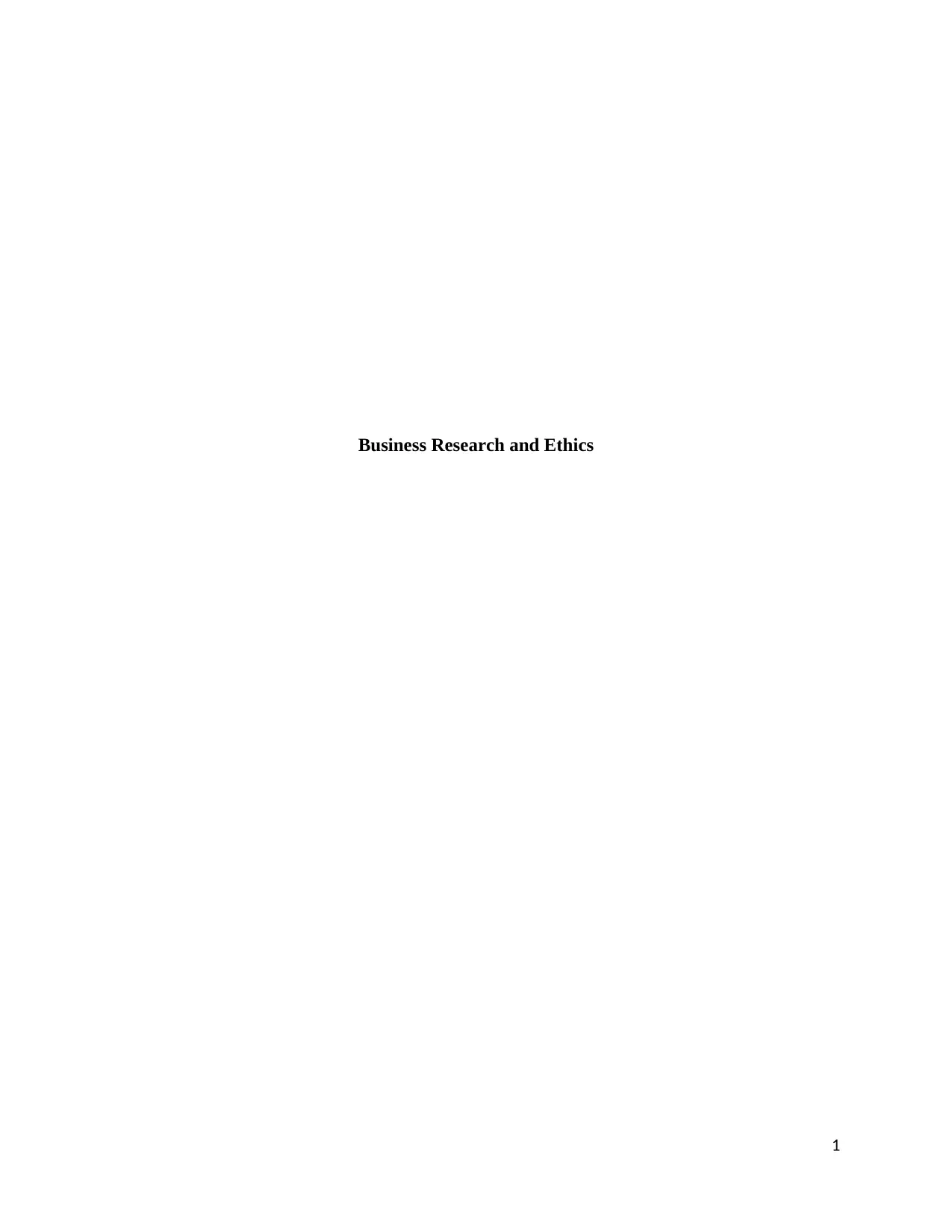
Business Research and Ethics
1
1
Paraphrase This Document
Need a fresh take? Get an instant paraphrase of this document with our AI Paraphraser
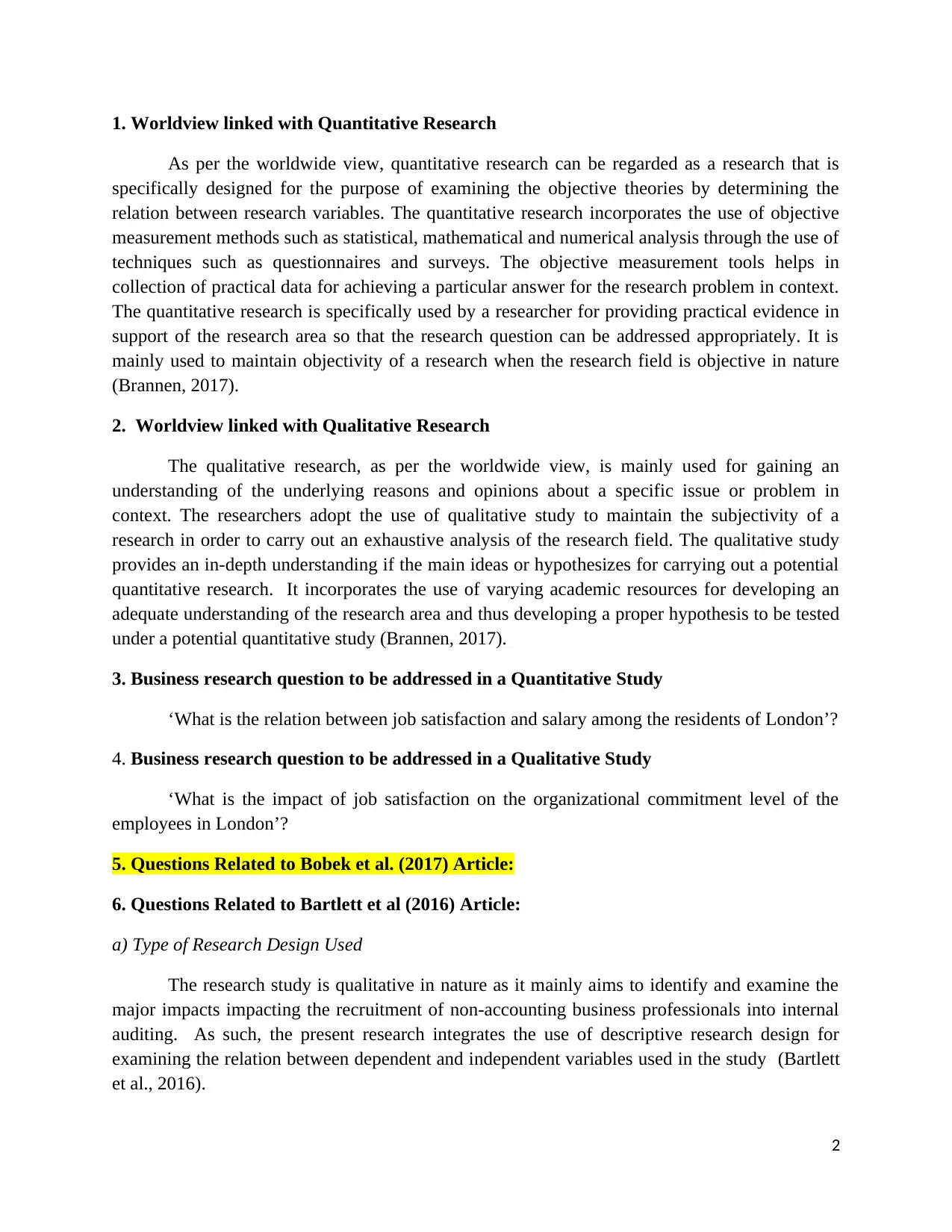
1. Worldview linked with Quantitative Research
As per the worldwide view, quantitative research can be regarded as a research that is
specifically designed for the purpose of examining the objective theories by determining the
relation between research variables. The quantitative research incorporates the use of objective
measurement methods such as statistical, mathematical and numerical analysis through the use of
techniques such as questionnaires and surveys. The objective measurement tools helps in
collection of practical data for achieving a particular answer for the research problem in context.
The quantitative research is specifically used by a researcher for providing practical evidence in
support of the research area so that the research question can be addressed appropriately. It is
mainly used to maintain objectivity of a research when the research field is objective in nature
(Brannen, 2017).
2. Worldview linked with Qualitative Research
The qualitative research, as per the worldwide view, is mainly used for gaining an
understanding of the underlying reasons and opinions about a specific issue or problem in
context. The researchers adopt the use of qualitative study to maintain the subjectivity of a
research in order to carry out an exhaustive analysis of the research field. The qualitative study
provides an in-depth understanding if the main ideas or hypothesizes for carrying out a potential
quantitative research. It incorporates the use of varying academic resources for developing an
adequate understanding of the research area and thus developing a proper hypothesis to be tested
under a potential quantitative study (Brannen, 2017).
3. Business research question to be addressed in a Quantitative Study
‘What is the relation between job satisfaction and salary among the residents of London’?
4. Business research question to be addressed in a Qualitative Study
‘What is the impact of job satisfaction on the organizational commitment level of the
employees in London’?
5. Questions Related to Bobek et al. (2017) Article:
6. Questions Related to Bartlett et al (2016) Article:
a) Type of Research Design Used
The research study is qualitative in nature as it mainly aims to identify and examine the
major impacts impacting the recruitment of non-accounting business professionals into internal
auditing. As such, the present research integrates the use of descriptive research design for
examining the relation between dependent and independent variables used in the study (Bartlett
et al., 2016).
2
As per the worldwide view, quantitative research can be regarded as a research that is
specifically designed for the purpose of examining the objective theories by determining the
relation between research variables. The quantitative research incorporates the use of objective
measurement methods such as statistical, mathematical and numerical analysis through the use of
techniques such as questionnaires and surveys. The objective measurement tools helps in
collection of practical data for achieving a particular answer for the research problem in context.
The quantitative research is specifically used by a researcher for providing practical evidence in
support of the research area so that the research question can be addressed appropriately. It is
mainly used to maintain objectivity of a research when the research field is objective in nature
(Brannen, 2017).
2. Worldview linked with Qualitative Research
The qualitative research, as per the worldwide view, is mainly used for gaining an
understanding of the underlying reasons and opinions about a specific issue or problem in
context. The researchers adopt the use of qualitative study to maintain the subjectivity of a
research in order to carry out an exhaustive analysis of the research field. The qualitative study
provides an in-depth understanding if the main ideas or hypothesizes for carrying out a potential
quantitative research. It incorporates the use of varying academic resources for developing an
adequate understanding of the research area and thus developing a proper hypothesis to be tested
under a potential quantitative study (Brannen, 2017).
3. Business research question to be addressed in a Quantitative Study
‘What is the relation between job satisfaction and salary among the residents of London’?
4. Business research question to be addressed in a Qualitative Study
‘What is the impact of job satisfaction on the organizational commitment level of the
employees in London’?
5. Questions Related to Bobek et al. (2017) Article:
6. Questions Related to Bartlett et al (2016) Article:
a) Type of Research Design Used
The research study is qualitative in nature as it mainly aims to identify and examine the
major impacts impacting the recruitment of non-accounting business professionals into internal
auditing. As such, the present research integrates the use of descriptive research design for
examining the relation between dependent and independent variables used in the study (Bartlett
et al., 2016).
2
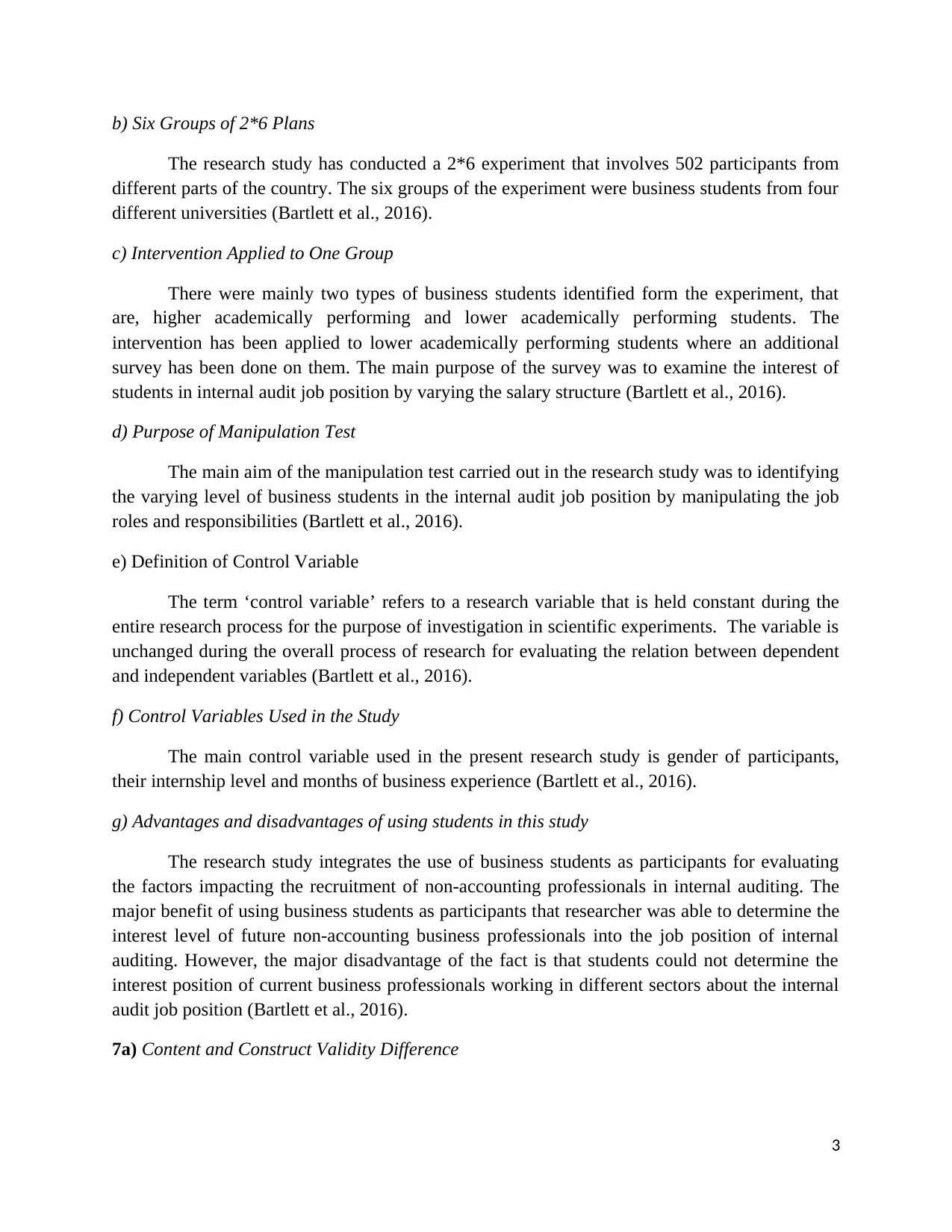
b) Six Groups of 2*6 Plans
The research study has conducted a 2*6 experiment that involves 502 participants from
different parts of the country. The six groups of the experiment were business students from four
different universities (Bartlett et al., 2016).
c) Intervention Applied to One Group
There were mainly two types of business students identified form the experiment, that
are, higher academically performing and lower academically performing students. The
intervention has been applied to lower academically performing students where an additional
survey has been done on them. The main purpose of the survey was to examine the interest of
students in internal audit job position by varying the salary structure (Bartlett et al., 2016).
d) Purpose of Manipulation Test
The main aim of the manipulation test carried out in the research study was to identifying
the varying level of business students in the internal audit job position by manipulating the job
roles and responsibilities (Bartlett et al., 2016).
e) Definition of Control Variable
The term ‘control variable’ refers to a research variable that is held constant during the
entire research process for the purpose of investigation in scientific experiments. The variable is
unchanged during the overall process of research for evaluating the relation between dependent
and independent variables (Bartlett et al., 2016).
f) Control Variables Used in the Study
The main control variable used in the present research study is gender of participants,
their internship level and months of business experience (Bartlett et al., 2016).
g) Advantages and disadvantages of using students in this study
The research study integrates the use of business students as participants for evaluating
the factors impacting the recruitment of non-accounting professionals in internal auditing. The
major benefit of using business students as participants that researcher was able to determine the
interest level of future non-accounting business professionals into the job position of internal
auditing. However, the major disadvantage of the fact is that students could not determine the
interest position of current business professionals working in different sectors about the internal
audit job position (Bartlett et al., 2016).
7a) Content and Construct Validity Difference
3
The research study has conducted a 2*6 experiment that involves 502 participants from
different parts of the country. The six groups of the experiment were business students from four
different universities (Bartlett et al., 2016).
c) Intervention Applied to One Group
There were mainly two types of business students identified form the experiment, that
are, higher academically performing and lower academically performing students. The
intervention has been applied to lower academically performing students where an additional
survey has been done on them. The main purpose of the survey was to examine the interest of
students in internal audit job position by varying the salary structure (Bartlett et al., 2016).
d) Purpose of Manipulation Test
The main aim of the manipulation test carried out in the research study was to identifying
the varying level of business students in the internal audit job position by manipulating the job
roles and responsibilities (Bartlett et al., 2016).
e) Definition of Control Variable
The term ‘control variable’ refers to a research variable that is held constant during the
entire research process for the purpose of investigation in scientific experiments. The variable is
unchanged during the overall process of research for evaluating the relation between dependent
and independent variables (Bartlett et al., 2016).
f) Control Variables Used in the Study
The main control variable used in the present research study is gender of participants,
their internship level and months of business experience (Bartlett et al., 2016).
g) Advantages and disadvantages of using students in this study
The research study integrates the use of business students as participants for evaluating
the factors impacting the recruitment of non-accounting professionals in internal auditing. The
major benefit of using business students as participants that researcher was able to determine the
interest level of future non-accounting business professionals into the job position of internal
auditing. However, the major disadvantage of the fact is that students could not determine the
interest position of current business professionals working in different sectors about the internal
audit job position (Bartlett et al., 2016).
7a) Content and Construct Validity Difference
3
⊘ This is a preview!⊘
Do you want full access?
Subscribe today to unlock all pages.

Trusted by 1+ million students worldwide
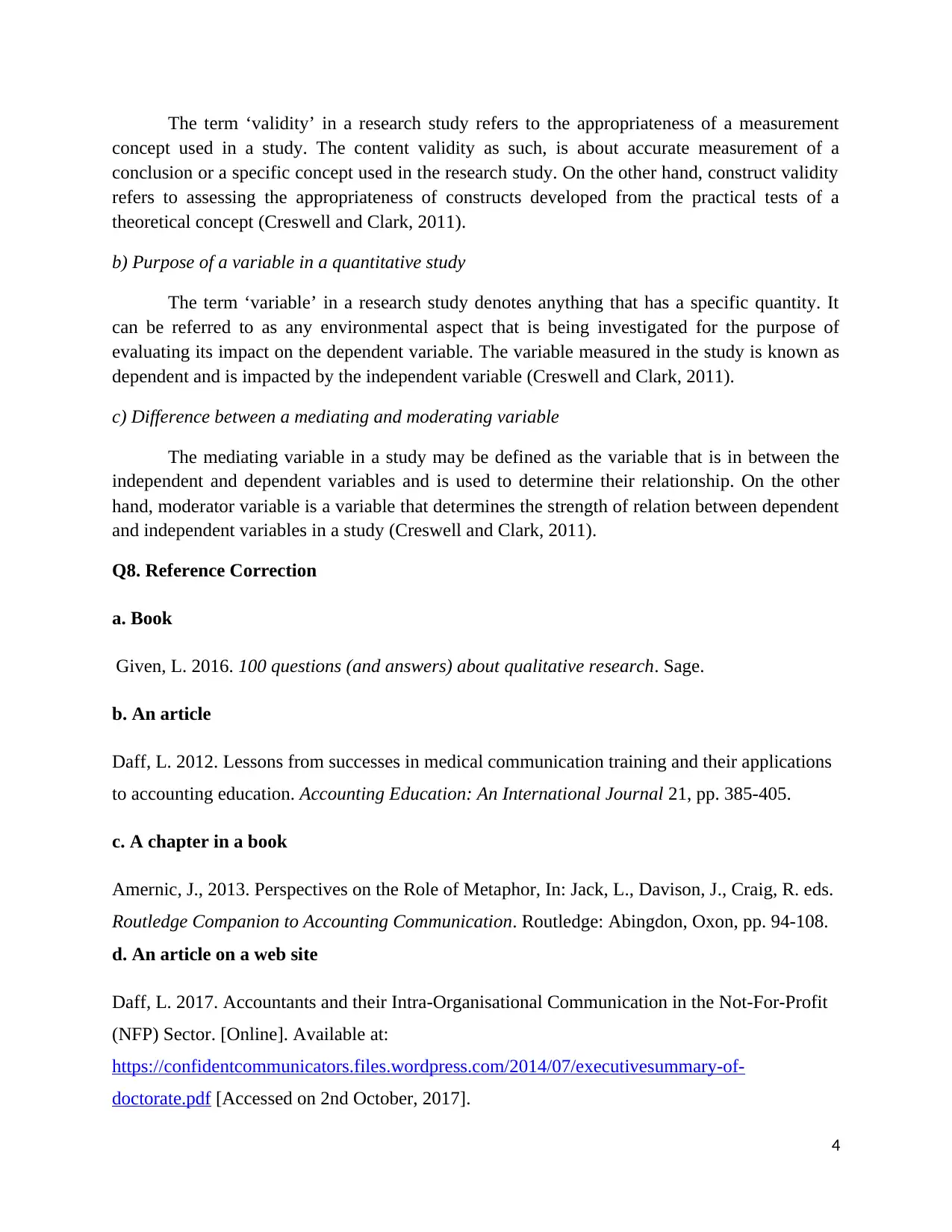
The term ‘validity’ in a research study refers to the appropriateness of a measurement
concept used in a study. The content validity as such, is about accurate measurement of a
conclusion or a specific concept used in the research study. On the other hand, construct validity
refers to assessing the appropriateness of constructs developed from the practical tests of a
theoretical concept (Creswell and Clark, 2011).
b) Purpose of a variable in a quantitative study
The term ‘variable’ in a research study denotes anything that has a specific quantity. It
can be referred to as any environmental aspect that is being investigated for the purpose of
evaluating its impact on the dependent variable. The variable measured in the study is known as
dependent and is impacted by the independent variable (Creswell and Clark, 2011).
c) Difference between a mediating and moderating variable
The mediating variable in a study may be defined as the variable that is in between the
independent and dependent variables and is used to determine their relationship. On the other
hand, moderator variable is a variable that determines the strength of relation between dependent
and independent variables in a study (Creswell and Clark, 2011).
Q8. Reference Correction
a. Book
Given, L. 2016. 100 questions (and answers) about qualitative research. Sage.
b. An article
Daff, L. 2012. Lessons from successes in medical communication training and their applications
to accounting education. Accounting Education: An International Journal 21, pp. 385-405.
c. A chapter in a book
Amernic, J., 2013. Perspectives on the Role of Metaphor, In: Jack, L., Davison, J., Craig, R. eds.
Routledge Companion to Accounting Communication. Routledge: Abingdon, Oxon, pp. 94-108.
d. An article on a web site
Daff, L. 2017. Accountants and their Intra-Organisational Communication in the Not-For-Profit
(NFP) Sector. [Online]. Available at:
https://confidentcommunicators.files.wordpress.com/2014/07/executivesummary-of-
doctorate.pdf [Accessed on 2nd October, 2017].
4
concept used in a study. The content validity as such, is about accurate measurement of a
conclusion or a specific concept used in the research study. On the other hand, construct validity
refers to assessing the appropriateness of constructs developed from the practical tests of a
theoretical concept (Creswell and Clark, 2011).
b) Purpose of a variable in a quantitative study
The term ‘variable’ in a research study denotes anything that has a specific quantity. It
can be referred to as any environmental aspect that is being investigated for the purpose of
evaluating its impact on the dependent variable. The variable measured in the study is known as
dependent and is impacted by the independent variable (Creswell and Clark, 2011).
c) Difference between a mediating and moderating variable
The mediating variable in a study may be defined as the variable that is in between the
independent and dependent variables and is used to determine their relationship. On the other
hand, moderator variable is a variable that determines the strength of relation between dependent
and independent variables in a study (Creswell and Clark, 2011).
Q8. Reference Correction
a. Book
Given, L. 2016. 100 questions (and answers) about qualitative research. Sage.
b. An article
Daff, L. 2012. Lessons from successes in medical communication training and their applications
to accounting education. Accounting Education: An International Journal 21, pp. 385-405.
c. A chapter in a book
Amernic, J., 2013. Perspectives on the Role of Metaphor, In: Jack, L., Davison, J., Craig, R. eds.
Routledge Companion to Accounting Communication. Routledge: Abingdon, Oxon, pp. 94-108.
d. An article on a web site
Daff, L. 2017. Accountants and their Intra-Organisational Communication in the Not-For-Profit
(NFP) Sector. [Online]. Available at:
https://confidentcommunicators.files.wordpress.com/2014/07/executivesummary-of-
doctorate.pdf [Accessed on 2nd October, 2017].
4
Paraphrase This Document
Need a fresh take? Get an instant paraphrase of this document with our AI Paraphraser
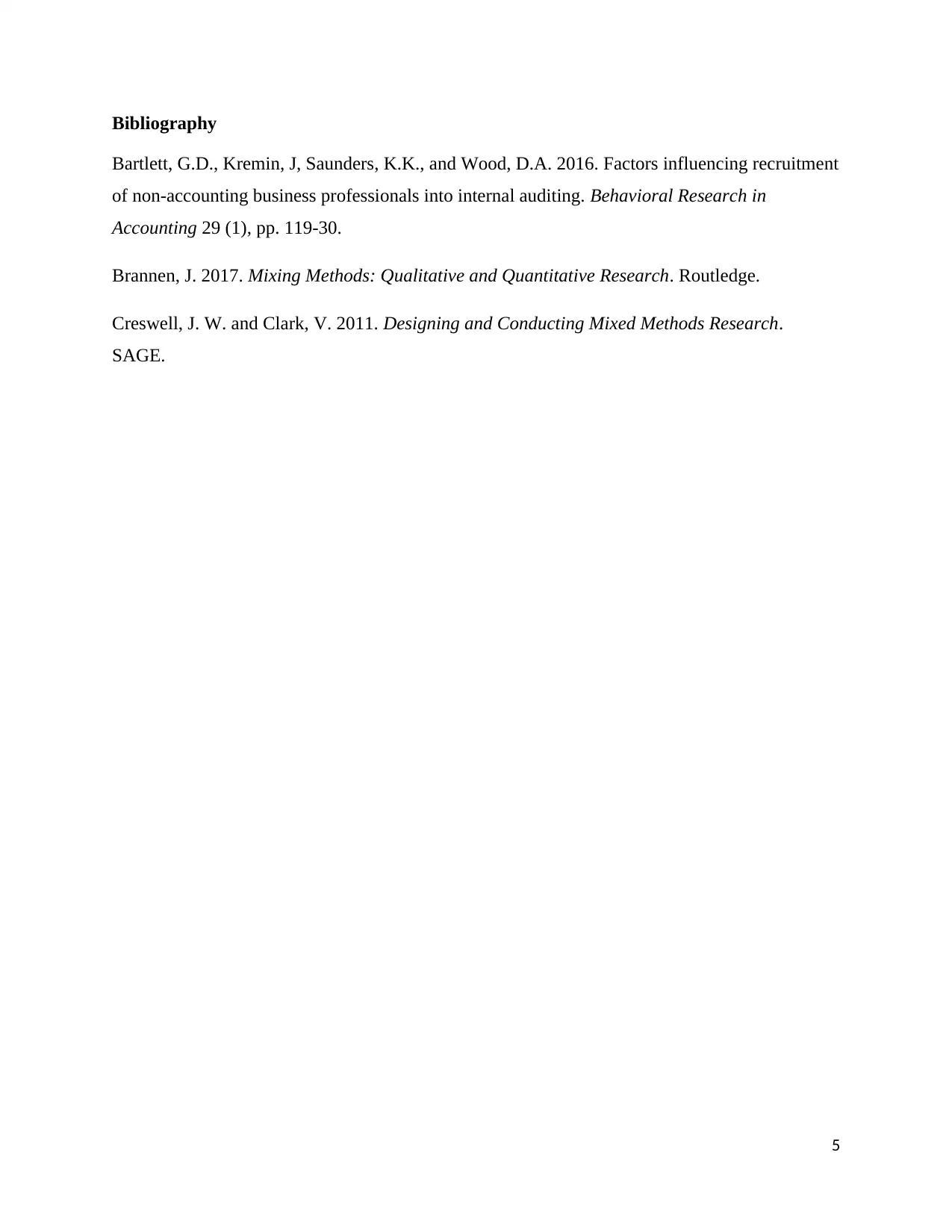
Bibliography
Bartlett, G.D., Kremin, J, Saunders, K.K., and Wood, D.A. 2016. Factors influencing recruitment
of non-accounting business professionals into internal auditing. Behavioral Research in
Accounting 29 (1), pp. 119-30.
Brannen, J. 2017. Mixing Methods: Qualitative and Quantitative Research. Routledge.
Creswell, J. W. and Clark, V. 2011. Designing and Conducting Mixed Methods Research.
SAGE.
5
Bartlett, G.D., Kremin, J, Saunders, K.K., and Wood, D.A. 2016. Factors influencing recruitment
of non-accounting business professionals into internal auditing. Behavioral Research in
Accounting 29 (1), pp. 119-30.
Brannen, J. 2017. Mixing Methods: Qualitative and Quantitative Research. Routledge.
Creswell, J. W. and Clark, V. 2011. Designing and Conducting Mixed Methods Research.
SAGE.
5
1 out of 5
Related Documents
Your All-in-One AI-Powered Toolkit for Academic Success.
+13062052269
info@desklib.com
Available 24*7 on WhatsApp / Email
![[object Object]](/_next/static/media/star-bottom.7253800d.svg)
Unlock your academic potential
Copyright © 2020–2025 A2Z Services. All Rights Reserved. Developed and managed by ZUCOL.




